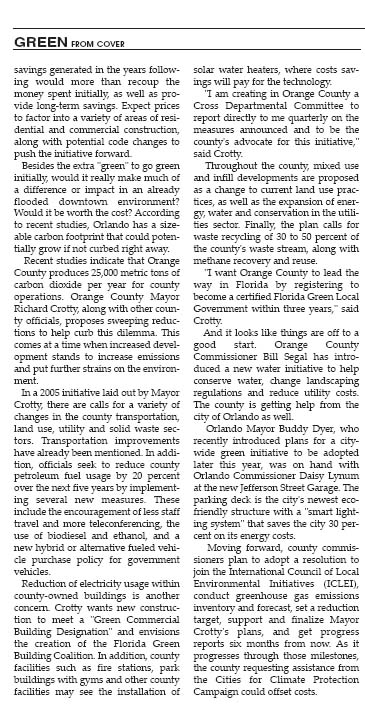Orlando Joining “Green-olution”
ORANGE COUNTY – With recent worldwide concerts to bring awareness to global warming, oodles of scientific studies about greenhouse gases and pollution, and terms like “carbon footprint” becoming hip, Orlando may be jumping on the bandwagon of the growing ‘Green-olution’ sweeping the country.

Orlando officials recently opened the first “green” parking deck, one of many structures designed to reduce pollution and make use of recycled resources in order to do its share to cut back on Orlando’s carbon footprint. In fact, they’re also reviewing the current growth-management plan to find ways to offset the continuous influx of people and facilities in the downtown and surrounding areas in order to accommodate cleaner, greener results.
Plans are in the works, as reported, to increase sidewalks and bike lanes to encourage more pedestrian traffic downtown to reduce the amount of vehicle congestion. The infamous commuter rail has been proposed time and again as a travel alternative, along with a sweeping re-design of I-4 and other streets and thoroughfares downtown. If these plans succeed, Orlando surely could make other Florida cities green with envy.
But just how much green will it take to ‘go green’? It’s one thing to build new structures at a savings, but if large scale conversion to greener pastures is to take place, will it be yet another burden to both the county and city government budgets? Not necessarily, according to the recently released Orlando County Climate Change Action Plan. While most changes would incur an additional cost upfront, officials contend that the savings generated in the years following would more than recoup the money spent initially, as well as provide long-term savings. Expect prices to factor into a variety of areas of residential and commercial construction, along with potential code changes to push the initiative forward.

Besides the extra “green” to go green initially, would it really make much of a difference or impact in an already flooded downtown environment? Would it be worth the cost? According to recent studies, Orlando has a sizeable carbon footprint that could potentially grow if not curbed right away.
Recent studies indicate that Orange County produces 25,000 metric tons of carbon dioxide per year for county operations. Orange County Mayor Richard Crotty, along with other county officials, proposes sweeping reductions to help curb this dilemma. This comes especially at a time where increased development stands to increase emissions and put further strains on the environment.
In a 2005 initiative laid out by Mayor Crotty, there are calls for a variety of changes in the county, transportation, land use, utility and solid waste sectors. Transportation improvements have already been mentioned. In addition, officials seek to reduce county petroleum fuel usage by 20% over the next five years by implementing several new measures. These include the encouragement of less staff travel and more teleconferencing, the use of biodiesel and ethanol, and a new hybrid or alternative fueled vehicle purchase policy for government vehicles.
Reduction of electricity usage within County-owned buildings is another concern. Mayor Crotty wants new construction to meet a “Green Commercial Building Designation” and envisions the creation of the Florida Green Building Coalition. In addition, county facilities such as fire stations, park buildings with gyms and other county facilities may see the installation of solar water heaters, where costs savings will pay for the technology.
“I am creating in Orange County a Cross Departmental Committee to report directly to me quarterly on the measures announced and to be the County’s advocate for this initiative,” said Mayor Crotty.
Throughout the county, mixed use and infill developments are proposed as a change to current land use practices, as well as the expansion of energy, water, and conservation in the utilities sector. Finally, the plan calls for waste recycling of 30-50% of the county’s waste stream, along with methane recovery and reuse.
“I want Orange County to lead the way in Florida by registering to become a certified Florida Green Local Government within three years,” said Mayor Crotty.
And it looks like things are off to a good start. Commissioner Segal has introduced a new Water Initiative to help conserve water, change landscaping regulations, and reduce utility costs. The county is getting help from the city of Orlando as well.
Orlando Mayor Buddy Dyer, who recently introduced plans for a city-wide green initiative to be adopted later this year, was on hand with District 5 Commissioner Daisy Lynum at the new Jefferson Street Garage. The parking deck is the city’s newest eco-friendly structure with a ‘smart lighting system’ that saves the city 30% on its energy costs.
Moving forward, county commissioners plan to adopt a resolution to join the International Council of Local Environmental Initiatives (ICLEI), conduct greenhouse gas emissions inventory and forecast, set a reduction target, support and finalize Mayor Crotty’s plans, and get progress reports six months from now. And, costs could be offset by the county requesting assistance from the Cities for Climate Protection® Campaign as it progresses through those milestones.
